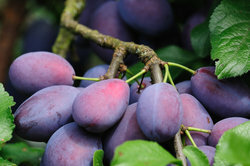Fight pests on the plum tree
With their numerous subspecies, plums are an asset to any garden, although they are not as popular as apples or pears, for example. The cultivation in the garden is relatively unproblematic. It only becomes more difficult when pests or diseases attack the plum tree.

General information about the plum tree
- The plum tree is a cultivated plant that belongs to the rose family. She grows as shrub or as a tree and can reach heights of up to 6 m, in very rare cases up to 10 m.
- The most widespread are the various subspecies of plum, such as the mirabelle plum, the plum, Renekloden or the common house plum. In the meantime, many new breeds are being offered on the market that are more tolerant of diseases and also tastier.
- In the case of new breeds, emphasis is placed on making the plum more resistant to pests and to make diseases, especially in relation to the Sharka disease, which predominantly affects the domestic plum infested. This disease has resulted in the plum being grown relatively rarely in some regions.
- In addition to the Scharka disease, the plum tree can u. a. can still be attacked by pests such as plum moth and aphid and diseases such as monilia fruit rot and fool's pocket disease.
Common diseases and pests and how to combat them
- A particularly dangerous viral disease is the aforementioned sharka disease, which is transmitted by aphids. Both leaves and fruits are attacked here. It manifests itself in light olive-green ring spots on the leaves. The fruits are cracked or crippled and fall off before they are ripe. This illness is notifiable in Germany. The virus cannot be combated directly, only its spread can be kept as low as possible.
- The so-called Monilia fruit rot is a fungal disease. It affects flowers, shoots and fruits equally. The fruits have rotten spots that spread over the entire fruit. In addition, white spore rings form, which cause further infections. You should immediately remove the affected fruit from the tree and dispose of it in the household waste. You should cut back affected shoots generously.
- The most important of the pests of the plum tree and house plum is the plum moth. It is a small, brownish butterfly, whose larvae drill small holes in the fruit and leave numerous small crumbs of excrement behind. You can combat this pest by placing a commercially available so-called fruit maggot collar around the trunk of the plum tree. The best time for this is August.
- Another representative of the pests is the mealy plum aphid. These aphids are whitish-green and excrete a relatively large amount of honeydew. So-called black fungi form on both the leaves and the fruits. The fruits wither. These aphids can also transmit sharka disease. You can fight the pest with spraying. Let yourself be best advised in this regard.
- The fool's pocket disease manifests itself in a white fungus coating on the fruits. In addition, the fruits have a curved, long shape, the skin is pale green and there is no core. Fruits that are obviously infested should be removed and disposed of with household waste.
Plum tree - diseases
The fruits taste best when they are fully ripe and immediately after the harvest ...
How helpful do you find this article?


